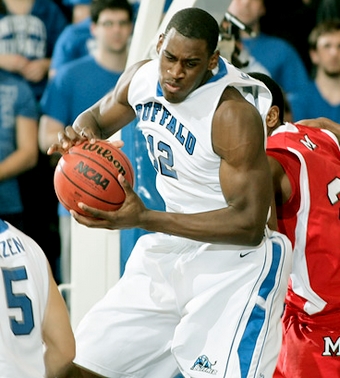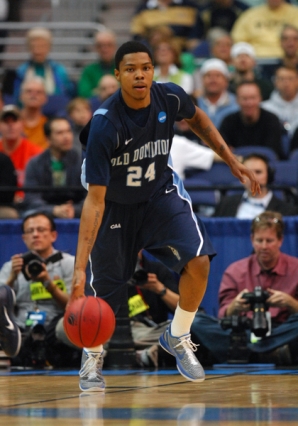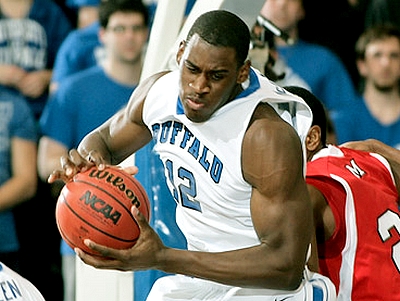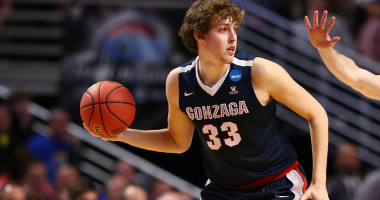Freshmen have been excluded from these previews, as we'd like to wait and see what they have to offer on the NCAA circuit before we come to any long-term conclusions.
-Top 20 Prospects in the Big Ten
-Top 25 Prospects in the ACC
-Top 15 Prospects in the Big 12
-Top 15 Prospects in the Pac-12
-Top 25 Prospects in the Big East
-Top 15 NBA Prospects in the SEC
-Top NBA Draft Prospects in the Non-BCS Conferences, Part One (#1-5)
-Top NBA Draft Prospects in the Non-BCS Conferences, Part Two (#6-10)
-Top NBA Draft Prospects in the Non-BCS Conferences, Part Three (#11-15)
#16 Javon McCrea, 6-6, Sophomore, Power Forward, Buffalo

Jonathan Givony
The youngest prospect in our college basketball database last season he turned 18 just a week before his first NCAA gameJavon McCrea nevertheless ranked as the most productive freshman in America thanks to his combination of brutally efficient scoring (#2 in FG%), offensive rebounding prowess and propensity for generating a large number of assists, steals and blocks on a per-minute basis.
McCrea is incredibly undersized at 6-6, but makes up for that with a NBA-ready frame, gigantic hands, an (alleged) 7-2 wingspan, and tremendous basketball instincts.
Not freakishly quick or explosive, McCrea is nevertheless a very fluid and mobile athlete, showing terrific coordination and aggressiveness. He's incredibly physical on the offensive glass, simply moving opponents around in the paint with his sheer girth, and pursuing loose balls relentlessly with outstanding instincts. He often comes up with rebounds from very difficult angles, as all he seemingly needs to do is get a fingertip on the ball to corral it with his gigantic hands.
McCrea only played 21 minutes per-game last season, but used 29% of his team's possessions when he was on the court, which is a very high rate. He gets his offensive production in a variety of ways at the MAC conference level, showing good versatility already for an undersized big man.
He can back down similarly sized players in the paint with his wide frame and solid footwork, and finishes with both hands around the basket with pretty soft touch. When double-teamed, McCrea shows very good instincts as a passer, once again hinting at his unexpectedly good feel for the game.
He's also capable of facing up on the perimeter, as he's a surprisingly good ball-handler who can drive either left or right and even change directions with the ball. He shows good footwork, a nice first step, and is extremely confident with the ball in his hands, which allows him to beat opposing big men fairly often and get to the free throw line at a solid rate.
On the negative side, McCrea's lack of experience and aggressiveness works against him at times, as he can be very turnover prone. He also doesn't possess any type of jump-shot at this stage, failing to convert a single jumper last season. He only made 51% of his free throws, indicating that he still has plenty of work to do in this area.
Defensively, McCrea gets tons of blocks and steals and is capable of being a real playmaker thanks to his length, hands and terrific instincts, but he has a ways to go in order to maximize his full potential on this end of the floor.
His lack of experience is an issue here as well. He tends to suffer from mental lapses at times and isn't immune from taking plays off. His fundamentals aren't great, as he gives up position in the paint too easily, gets lost off the ball and struggles badly when forced to step out onto the perimeter. McCrea's lateral quickness appears to be average at best, which will likely preclude him from making the conversion to the small forward position, which he'd be much better suited for due to his lack of size.
He's also surprisingly average on the defensive glass, pulling down just 6.4 rebounds per-40 minutes pace adjusted, a mark that is nothing to write home about considering the conference he plays in. He chases blocks wildly at times and doesn't box out his man on every possession, seemingly showing less enthusiasm here than he does offensively, which may be partially due to conditioning issues. It will be interesting to see how he develops in this area over time.
Younger than some freshmen who are only now entering collegesuch as Austin Rivers, Josiah Turner, Kyle Wiltjer and Khem BirchMcCrea was a very pleasant surprise last season as a completely unheralded recruit. We'll see if he can continue to produce consistently as his minutes and notoriety increases and whether he can round out the rest of his game to make himself more attractive as an NBA prospect. His lack of size will always be an issue, but we've recently seen players like Ike Diogu, Jason Maxiell and DeJuan Blair be able to overcome that through sheer production in the past.
#17 Kent Bazemore, 6-5, Small Forward, Senior, Old Dominion

Joseph Treutlein
After steadily improving his game his first three years at Old Dominion, Kent Bazemore has developed into a very solid college player with some interesting attributes from an NBA perspective. Despite boasting just a modest stat line with 12.3 points per game, Bazemore's athletic abilities and style of play could make him allow his game to translate well to the next level.
Standing 6'5 with a thin but wiry strong frame, Bazemore has good length and great athleticism for a wing, possessing both nice speed and reactive leaping ability. Playing a style of play well suited to his strengths, Bazemore displays a high motor on the offensive end and frequently contributes on cuts, spot-up drives, and put-back attempts that allow him to take advantage of his explosiveness.
Offensively, Bazemore could best be described as a jack of all trades but master of none, showing flashes in virtually every area but not being a go-to scorer or excelling especially in any specific area. He does most of his damage in the lane in a variety of ways, being aggressive going to the rim and creating shot attempts around the basket.
In terms of attacking off the dribble, Bazemore's skill set lacks a certain degree of polish, with him not having much in terms of advanced moves. He does most of his damage on variations of straight line drives, often starting with a half step on his man by virtue of ball movement in Old Dominion's offense, but he does show intrigue in a few areas here.
The most interesting aspect of the left-handed Bazemore's dribble-drive game is his equal ability taking the ball in both directions, being competent with both his left and right-handed dribbles. He also does a good job taking advantage of his quick first step and ability to elevate easily off the dribble, showing good ability to get past his man and rise for quality lay-up attempts. On the negative side, Bazemore's lack of polish can turn into a lack of control at times, which shows as he turns the ball over on a fairly high 21% of his possessions.
As a finisher around the basket, Bazemore shows nice creativity, instincts, and touch, often using glass on his finesse moves and being able to mix things up with floaters and runners or going up for a dunk. He elevates very easily both with and without the ball, something that shows especially in the halfcourt where he's a potent threat on cuts and backdoor alley-oop plays.
Somewhat surprising given his low scoring numbers, Bazemore also shows solid ability as a perimeter shooter, being capable hitting both pull-up mid-range jumpers and spot-up three pointers. This area of his game isn't as consistent as his ability to get to and finish around the rim, but Bazemore has a nice foundation to work with here.
Bazemore hit 40.8% of his three-pointers on a small sample of 2.2 attempts per game as a junior, but that still made up a decent chunk of his offense given his small scoring production overall. He shows decent form with adequate release height and speed when open, and it will be interesting to see if his high efficiency numbers hold up for another season or were just a fluke of small sample size, as he made 26.5% and 30% of his 3-pointers as a freshman and sophomore, again on a very limited sample size.
Bazemore also shows some potential hitting pull-up mid-range jumpers, but this is probably the weakest aspect of his game overall, and not something he's very efficient with. He's respectable in this regard when pulling up in space, but shows accuracy problems when contested, and is probably not something he'd be asked to do at the next level anyway.
Bazemore also does a solid job contributing in the little areas, moving well off the ball, attacking the offensive glass, and being an unselfish player with decent vision and passing ability for a wing, racking up a solid 4.2 assists per-40 minutes pace adjusted, mostly on ball movement but also occasionally on simple drive-and-dishes.
On the defensive end, Bazemore is a bit of a mixed bag, on one hand being a disruptive force utilizing his length and athleticism in the passing lanes, picking off 3.2 steals and even 1.3 blocks per-40p, but his commitment to fundamentals in isolation situations isn't always consistent. Despite showing good aggressiveness and a solid stance to open most possessions, along with doing a good job staying focused off the ball, Bazemore often lets out of his stance easily and doesn't keep up with his man laterally on many drives, not really showing the commitment to be the defender he's capable of with his tools. As a potential role-playing wing with limited shot creation abilities, really buckling down in this area will likely be critical for his NBA chances.
Looking forward, Bazemore should be getting his due diligence looks from all NBA teams this season, and will have ample opportunities to impress if he can further improve his numbers and continue to develop his all-around skills. His athletic tools, comfort level as a role player, and his many off-ball skills could potentially translate well to the NBA, but really stepping up on the defensive end will likely be crucial to his stock. A solid season could definitely put him into second round discussions, but he should have chances to find his way into the league next year or down the road regardless, should he continue to develop his skill-level.
#18 Bradford Burgess, 6'6, Senior, Small Forward, VCU

Matt Williams
Few players in college basketball boosted their NBA prospects as significantly as Bradford Burgess did during last year's post season. Lightly recruited as a high school senior coming out of Benedictine High School in Virginia, Burgess opted to attend VCU, located only a few miles away from the school's gym.
Though Burgess was not an immediate star for the Rams, he saw significant playing time as a freshman and has improved steadily in each of his seasons with the standout mid-major program. With the departures of Joey Rodriguez and Jamie Skeen opening up opportunities for him on the offensive end and a summer experience at the Kevin Durant Skills Academy, Burgess will be looked upon to pick up the slack in his final year in Richmond. A remarkably efficient role-player at this juncture, Burgess already has a number of potentially valuable skills, but improvement in a few key areas could boost his perception among scouts considerably for the second straight season.
Standing 6'6 with a frame that he's clearly worked on since his freshman year, Burgess has good size for a wing at the NBA level. His long arms allow him to play bigger and make an impact in the passing lanes on the defensive end. Burgess is not a high flier, nor does he has true blow-by quickness, but he's a decent athlete by NBA standards similar to Marquette standout Jimmy Butler who maximizes the athleticism he does have by showing an impressively relentless commitment to running the floor in transition and playing scrappy defense.
Burgess's offensive game is characterized first and foremost by his efficiency from the perimeter. According to Synergy Sports Technology, Burgess connected on an outstanding 45.4% of his catch and shoot attempts from the perimeter as a junior. His prolific shooting is thanks in large part to his extremely sound mechanics that seldom waiver in the slightest, even when he is well defended. At this juncture, Burgess already has the potential to stretch the floor at the NBA level and knock down the ever important corner three, and while he didn't shoot many deep three-pointers last season, he has the framework to become a threat from beyond the NBA line.
While Burgess is an excellent spot-up threat, he has plenty of room to grow as a shot creator and midrange scorer, as evidenced by his paltry 42% 2-point conversion rate. Burgess attempted just 17 pull-up jump shots last season, and though part of his limited sample from the midrange is due to his commitment to playing his role offensively and not forcing things, his ability to show that he can create his own shot and aggressiveness on the offensive end are worth keeping an eye on. Burgess does not show off much in the way of advanced ball handling ability, though he does manage to get to the rim pretty consistently when he does put the ball on the deck. In the long-term he would benefit from being a threat to knock down one-dribble jump shots and make simple moves to create his own shot to use his ability to stretch the floor to his advantage.
Although Burgess doesn't create many shots at the rim for himself, he still managed to make an impact at the basket on the offensive end. Extremely energetic in transition and half court sets alike, Burgess's length and ability to fill lanes made him a common target of dump passes last season. Whether he was setting a screen in the pick and roll, running the give-and-go out of one of Shaka Smart's sets, or getting up the floor off of a missed shot, Burgess does a great job putting himself in the right place at the right time, embracing contact at the rim, and finishing the play.
Defensively, Burgess shows a solid understanding of the fundamentals and does what is asked of him within VCU's concept. His lateral quickness it not off the charts, but the rising senior doesn't give up anything easy, shows some versatility when defending the post, and rebounds the ball at a good rate for a wing. Burgess uses his length well to play the passing lane and block the occasional shots around the rim in the college game, but long term it would be nice to see him add some muscle to his frame to improve his ability to matchup with the more talented, athletic wings he'd be asked to guard at the NBA level and leave his feet less frequently when closing out shooters
Though Burgess is not an elite player in any one category, his combination and size, shooting ability, and team-first gives him intriguing role-player potential. If he can improve his ability to score inside the arc, he could emerge as one of the more interesting mid-major wing prospects in the country. Considering the trajectory of his career, it would not be at all surprising to see him step up once again for Shaka Smart's Rams.
#19 Olek Czyz, 6'7, Senior, SF/PF, Nevada

Derek Bodner
Despite being a 21 year old entering his senior year, Olek Czyz hasn't logged very many minutes at the collegiate level. Entering Duke as a prized recruit out of Reno, Nevada, the native of Poland played sparse minutes during a little over a year at Durham before transferring back to Reno, this time as a member of the Nevada Wolf Pack.
The transfer away from Duke cost Czyz all but 6 games of his sophomore year and required him to sit out the first semester of his junior year at Nevada. This has left the incoming senior not having played a full season of college basketball yet and with much to prove, much like his underachieving Nevada team.
Czyz stands 6'7 and is a very good run and jump athlete, playing primarily as a face-up power forward at Nevada, which has allowed him to become an extremely efficient inside-outside threat at the collegiate level. Not being an especially prolific shooter in high school, Czyz's form and consistency has improved immensely, to the point where his 1.294 points per possession on jump shots was among the top 3 percent in college basketball last year according to Synergy Sports Technology. While not getting tremendous elevation in his release, Czyz shows a consistent, repeatable release with good balance and follow through. Czyz converted an astounding 48.9% of his catch and shoot opportunities last year, a skill set that would translate well to the next level as his role changes.
While not a high volume post player, Czyz does offer some ability down there when the matchup is advantageous. He primarily operates over his right shoulder, with a combination of left handed hooks and drives that may catch some defenders off, as Czyz is right handed. His footwork in the post also appears to be improving, as he's showing some spins, up and under, and counter moves that have expanded his post repertoire.
To effectively make the conversion to the small forward position, Czyz would benefit from improving his ball-handling ability. He's capable of getting to the hoop on straight line lives, and is a good leaper, but doesn't offer much in the way of advanced ball handling moves on the perimeter, and can be turnover prone when asked to do too much. He's once again left handed dominant, preferring to drive and finish with his left hand. His touch around the hoop isn't stellar, but he has good leaping ability and doesn't shy away from contact, getting to the line a respectable 5.5 times per 40 minutes pace adjusted.
Off the ball, Czyz moves well, and his previously mentioned catch and shoot ability is a skill that should translate fairly well. He moves well on cuts, and has solid hands and gets off the ground quickly, allowing him to be effective despite not having great touch around the hoop. He also has a strong second jump, so while not a prolific offensive rebounder he does a good job of converting these opportunities when he gets them.
Czyz can appear to be out of control at times offensively, forcing shots with a higher degree of difficulty than he needs to. While he displays a consistently high effort level, he will need to reign that in and play smart offensive basketball to successfully convert to a role player at the next level.
He's also a surprisingly poor free throw shooter considering his 3-point prowess, making just 60% of his attempts from the charity stripe last year.
How Czyz will translate on the defensive side of the ball is cause for concern. He doesn't have the size, lower body strength or length to play the power forward for extending periods of time at the next level, and his poor defensive rebounding (5.4 defensive rebounds per 40 minutes, pace adjusted) would be towards the bottom of our database for a power forward prospect. On the perimeter, his lateral foot speed is an issue, and he can at times get lost off the ball and seems to lack focus. What position he can defend, if any, may be the most important question he can answer when battling for a NBA roster spot.
After starting the season 2-7 while Czyz sat out, the Wolf Pack went a more respectable 11-12 down the stretch with him in the lineup. Returning 4 double digit scorers, Nevada should be in position to be better than they were last year, which could help Czyz gain some much-needed exposure. Czyz's spot-up shooting ability and run and jump athleticism potentially allows him to fit in the right offensive scheme as a role player, but he will have to show that he can play more under control and, more importantly, show that he can competently defend a position at the next level.
#20 Kyle O'Quinn, 6-10, Center/Power Forward, Senior, Norfolk State

Walker Beeken
Norfolk State big man Kyle O'Quinn has made gradual improvement over the course of his collegiate career, and will look to continue that improvement in his senior season to put himself on the radar of NBA scouts. O'Quinn's impressive averages of 16.4 ppg, 11.1 rpg, and 3.4 bpg on 55.6% from the field earned him first team all-conference honors in the MEAC last season.
Standing 6'10 and 240 pounds with what appears to be long wingspan, O'Quinn has nice size for an NBA big man prospect. While not a particularly explosive athlete, he does move fluidly and has good mobility for a player his size. His lack of energy and intensity on a consistent basis is a concern, but he is the most talented big man on the floor most every night in the MEAC, and he's able to dominate in the paint on both ends regardless of how much effort he puts forth.
Offensively, O'Quinn does much of his damage in the post, converting an efficient 63% of his 2-point attempts, displaying a nice array of moves and a fairly polished skill set in one on one situations. Where he gets himself into trouble is when the defense collapses on him, He draws so much attention from opposing teams' defenses, but he lacks the awareness and passing ability out of the post, showing that his feel for the game is still a work in a progress.
O'Quinn has shown the ability to step out on the perimeter as well, but his shot selection was horrific at times last season, far too often settling for long range jumpers. He connected on a poor 25% of his jump shots as a junior, and only 24% of his 3-pointers, attempting two per game. He has a decent stroke, as shown by the fact that he shot a solid 76% from the free throw line, but most of his jumpers seem to be a result of boredom or out of frustration if he doesn't touch the ball for a few possessions. He can turn his shooting ability into an asset, but he'll need to get much better at recognizing what is a good shot.
On the defensive end, O'Quinn is an enforcer in the paint, and was named Defensive Player of the Year in the MEAC last season. Being the most physically gifted big man on the floor most every night, he's able to block or alter shots in the paint as a help defender and clean up on the defensive boards. He's also able to get away with not always fighting for positioning and playing good fundamental defense at a lower level of competition, but he'll likely need to make some serious adjustments against NBA caliber players, and show a much higher level of focus and toughness.
Overall, O'Quinn has good size and a versatile skill set for a player his size, and has shown to be very productive at the college level, albeit in a weak conference. A dominating senior season might help to boost his stock, but he tends to coast at times, and the lack of talent he faces on a regular basis makes it difficult to project how well his game might translate against a much higher level of competition. Getting drafted next summer will be an uphill battle, but he'll likely get his chance to prove his worth through the pre-draft process in workouts and at Portsmouth.











































Comments